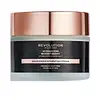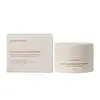What's inside
What's inside
 Key Ingredients
Key Ingredients

 Benefits
Benefits

 Concerns
Concerns

 Ingredients Side-by-side
Ingredients Side-by-side

Water
Skin ConditioningCaprylic/Capric Triglyceride
MaskingShorea Stenoptera Seed Butter
EmollientGlycerin
HumectantPrunus Persica Kernel Oil
EmollientSodium Acrylates Copolymer
Phenoxyethanol
PreservativePolyacrylamide
Lecithin
EmollientC13-14 Isoparaffin
EmollientSodium Hyaluronate
HumectantGlycogen
HumectantChlorphenesin
AntimicrobialLaureth-7
EmulsifyingTocopherol
AntioxidantHelianthus Annuus Seed Oil
EmollientCitric Acid
BufferingWater, Caprylic/Capric Triglyceride, Shorea Stenoptera Seed Butter, Glycerin, Prunus Persica Kernel Oil, Sodium Acrylates Copolymer, Phenoxyethanol, Polyacrylamide, Lecithin, C13-14 Isoparaffin, Sodium Hyaluronate, Glycogen, Chlorphenesin, Laureth-7, Tocopherol, Helianthus Annuus Seed Oil, Citric Acid
Water
Skin ConditioningArgania Spinosa Kernel Oil
EmollientDimethicone
EmollientCyclopentasiloxane
EmollientSqualane
EmollientGlycerin
HumectantPolyacrylamide
Lactobacillus/Punica Granatum Fruit Ferment Extract
Skin ConditioningGlyceryl Stearate
EmollientPEG-100 Stearate
Polysilicone-11
C13-14 Isoparaffin
EmollientPalmitoyl Pentapeptide-4
Skin ConditioningCroton Lechleri Resin Extract
Skin ConditioningLeuconostoc/Radish Root Ferment Filtrate
AntimicrobialSucrose Palmitate
EmollientPanthenol
Skin ConditioningSodium Acrylates Copolymer
Caprylyl Glycol
EmollientLaureth-7
EmulsifyingGlyceryl Linoleate
EmollientTocopheryl Acetate
AntioxidantLecithin
EmollientSodium Hyaluronate
HumectantPhenoxyethanol
PreservativePotassium Sorbate
PreservativeCitric Acid
BufferingDisodium EDTA
Parfum
MaskingWater, Argania Spinosa Kernel Oil, Dimethicone, Cyclopentasiloxane, Squalane, Glycerin, Polyacrylamide, Lactobacillus/Punica Granatum Fruit Ferment Extract, Glyceryl Stearate, PEG-100 Stearate, Polysilicone-11, C13-14 Isoparaffin, Palmitoyl Pentapeptide-4, Croton Lechleri Resin Extract, Leuconostoc/Radish Root Ferment Filtrate, Sucrose Palmitate, Panthenol, Sodium Acrylates Copolymer, Caprylyl Glycol, Laureth-7, Glyceryl Linoleate, Tocopheryl Acetate, Lecithin, Sodium Hyaluronate, Phenoxyethanol, Potassium Sorbate, Citric Acid, Disodium EDTA, Parfum
Ingredients Explained
These ingredients are found in both products.
Ingredients higher up in an ingredient list are typically present in a larger amount.
This ingredient is also known as "C13-14 Isoalkane".
C13-14 Isoparaffin is created from petroleum-based mineral oils. It is an emollient and helps thicken a product.
As an emollient, it helps keep the skin soft and smooth by creating a barrier on top. This barrier traps moisture in, keeping the skin hydrated.
C13-14 Isoparaffin may not be fungal-acne safe.
Learn more about C13-14 IsoparaffinCitric Acid is an alpha hydroxy acid (AHA) naturally found in citrus fruits like oranges, lemons, and limes.
Like other AHAs, citric acid can exfoliate skin by breaking down the bonds that hold dead skin cells together. This helps reveal smoother and brighter skin underneath.
However, this exfoliating effect only happens at high concentrations (20%) which can be hard to find in cosmetic products.
Due to this, citric acid is usually included in small amounts as a pH adjuster. This helps keep products slightly more acidic and compatible with skin's natural pH.
In skincare formulas, citric acid can:
While it can provide some skin benefits, research shows lactic acid and glycolic acid are generally more effective and less irritating exfoliants.
Most citric acid used in skincare today is made by fermenting sugars (usually from molasses). This synthetic version is identical to the natural citrus form but easier to stabilize and use in formulations.
Read more about some other popular AHA's here:
Learn more about Citric AcidGlycerin is already naturally found in your skin. It helps moisturize and protect your skin.
A study from 2016 found glycerin to be more effective as a humectant than AHAs and hyaluronic acid.
As a humectant, it helps the skin stay hydrated by pulling moisture to your skin. The low molecular weight of glycerin allows it to pull moisture into the deeper layers of your skin.
Hydrated skin improves your skin barrier; Your skin barrier helps protect against irritants and bacteria.
Glycerin has also been found to have antimicrobial and antiviral properties. Due to these properties, glycerin is often used in wound and burn treatments.
In cosmetics, glycerin is usually derived from plants such as soybean or palm. However, it can also be sourced from animals, such as tallow or animal fat.
This ingredient is organic, colorless, odorless, and non-toxic.
Glycerin is the name for this ingredient in American English. British English uses Glycerol/Glycerine.
Learn more about GlycerinLaureth-7 is created by the ethoxylation of lauryl alcohol using ethylene oxide. Lauryl alcohol is a fatty alcohol with hydrating properties.
This ingredient is an emulsifier and cleansing ingredient. As an emulsifier, it is used to prevent ingredients from separating. It also helps cleanse the skin by gathering dirt, oil, and pollutants to be rinsed away.
Lecithin is a term for a group of substances found in the cell membranes of plants, animals, and humans. They are made up of mixture of phospholipids.
This ingredient has emollient and emulsifying properties.
As an emollient, lecithen helps soften the skin and creates a barrier to keep moisture in.
As an emulsifier, it also helps prevent water and oil ingredients from separating. Lecithin can also help ingredients be better absorbed by the skin.
This is because the phospholipids in lecithin produce liposomes. Liposomes help other ingredients get through the skin barrier.
Depending on the source of this ingredient, lecithin may not be fungal acne safe. This is because some sources of lecithin come from soybean oil, which may feed the malassezia yeast that feeds fungal acne.
We recommend reaching out to the brand you are purchasing from to inquire about the source of their lecithin.
Some other names for this ingredient include soy lecithin and deoiled soy lecithin.
Learn more about LecithinPhenoxyethanol is a preservative that has germicide, antimicrobial, and aromatic properties. Studies show that phenoxyethanol can prevent microbial growth. By itself, it has a scent that is similar to that of a rose.
It's often used in formulations along with Caprylyl Glycol to preserve the shelf life of products.
Polyacrylamide is a synthetic polymer. It is used to stabilize products and bind ingredients. When hydrated, Polyacrylamide forms a soft gel.
Polyacrylamide is low-toxicity. If source properly, it is deemed safe to use in cosmetics.
It should be noted the precursor to Polyacrylamide is acrylamide. Acrylamide is a carcinogen. Most reputable sources of Polyacrylamide will screen for residual acrylamide to make sure the count is in a safe range. Acrylamide is not able to be absorbed through the skin.
We recommend speaking with a professional if you have concerns.
Learn more about PolyacrylamideWe don't have a description for Sodium Acrylates Copolymer yet.
Sodium Hyaluronate is hyaluronic acid's salt form. It is commonly derived from the sodium salt of hyaluronic acid.
Like hyaluronic acid, it is great at holding water and acts as a humectant. This makes it a great skin hydrating ingredient.
Sodium Hyaluronate is naturally occurring in our bodies and is mostly found in eye fluid and joints.
These are some other common types of Hyaluronic Acid:
Learn more about Sodium HyaluronateWater. It's the most common cosmetic ingredient of all. You'll usually see it at the top of ingredient lists, meaning that it makes up the largest part of the product.
So why is it so popular? Water most often acts as a solvent - this means that it helps dissolve other ingredients into the formulation.
You'll also recognize water as that liquid we all need to stay alive. If you see this, drink a glass of water. Stay hydrated!
Learn more about Water